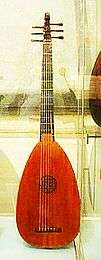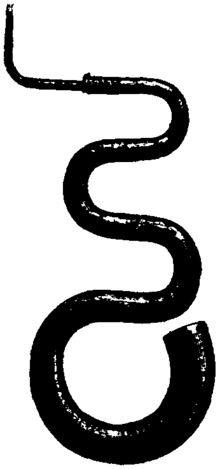Mandora
The mandora also known as gallichon is type of 18th and early 19th century lute, with 6 to 9 courses of strings. The terms were interchangeable, with Mandora common in Northern Italy and Central Europe, and Gallichon in Germany.
History


Mandora or gallichon generally refers to a bass lute from the 1700, with the vibrating string length of 72 centimeters or greater, used in Germany and Bohemia. It could be either single- or double-strung.[1]
James Tyler pointed out in his book The Early Mandolin that the word mandora was rarely encountered before the 18th century.[2] Then, it referred to a large bass lute.[2] The gallichone, as it was better known,[2] was a type of 6 or 8-course bass lute (possibly a descendant of the guiterne and/or chitarra italiana[3]) used, mainly for basso continuo, in Germany, Austria and Bohemia particularly during the 18th and early 19th centuries.[4] It was also called the galizona or galichon. Tyler disputed that it was mainly used for continuo, saying it was used "both as a solo and as a continuo instrument".[2]
Modern era music was written for the gallichon by Ruggero Chiesa (1933-1993). Other composers included the German Schiffelholtz and the Italian Brescianello. Chiesa also called the instrument the colascione. Gottfried Finger suggested that it was used in Boheman musical circles.[1]
Construction
The bass type, similarly to the theorbo and other baroque lutes, has a vaulted body (shell) constructed of separate ribs, a flat soundboard with either a carved rose or one which is inset into the soundhole, and a bridge (without a saddle) consisting of a wooden bar acting as a string-holder glued to the soundboard. Unique to this instrument is the neck, which is long enough to allow for ten to 12 tied gut frets. The pegbox is either straight and set at a sharp angle to the neck (much like a lute pegbox), or gently curving and set at a shallow angle, either case being fitted with laterally-inserted tuning pegs (although sometimes a flat pegboard with sagittal pegs is found). The strings were of gut and are strung either singly or, especially on Italian instruments, in double courses. However, on German-made instruments, the first course (highest in pitch) is usually single (a chanterelle) and often has its own separate raised peg rider/holder attached to the pegbox. The number of courses varies from six to eight. Open string lengths tend to be fairly long (62–72 cm) on German instruments, but shorter (55–65 cm) on late Italian ones, probably because they tended to be tuned to a higher pitch.
Luthiers who produced mandoras in the first half of the 18th century were Gregor Ferdinand Wenger in Augsburg, Jacob Goldt of Hamburg, Jacob Weiss of Salzburg, David Buchstetter of Regensburg and Mattias Greisser of Innsbruck. Italian-style instruments are represented by Martino Hell of Genoa, Enrico Ebar of Venice, David Tecchler of Rome, Antonio Scoti of Milan and, toward the end of the century, Antonio Monzino and Giuseppe Presbler of Milan.
At least 50 original instruments survive in collections around the world. Examples are found in museums in Berlin, Claremont (California), Copenhagen, Edinburgh, The Hague, Leipzig, Milan, Munich and Paris, New York and St. Petersburg. Many of these instruments are found in a more or less unaltered state, and therefore are often used as models for modern reconstructions.
Tuning
In the 18th century, mandora was the name of a six-course lute instrument of about 70 cm string length, tuned F - G - c - f - a - d' or G - A - d - g - b - e' (rarely with two or three additional bass courses). With the former tuning, the instrument was called Calichon or Galichon in Bohemia.
Around 1800, a mutual interchange between the mandora and the guitar took place. The guitar, which had so far been tuned in re-entrant tuning (e' - b - g - d' - a), took over the 6th course and the tuning of the mandora (e' - b - g - d - A - G, later also e' - b - g - d - A - E), whereas the mandora took over the stringing with single strings instead of courses, as had been introduced to the guitar. The so-called wandervogellaute has been a late heir to that development.
From another source on tuning:
Two tunings are reported: a ‘galizona’ or ‘colachon’ is tuned A'( or ) –B'( or ) –C–D–G–c–e–a, and, under a separate heading, ‘mandora’ is given as D ( or ) –E ( or ) –F–G–c–f–a–d' (i.e. the same tuning but a 4th higher) or E–A–d–g–b–e' (identical to that of the modern guitar)
The playing technique for the mandora involves the same basic right-hand finger style as for all 18th-century lutes and, because of the tuning intervals of the upper five courses, a left-hand technique that is similar to that of the 18th-century guitar.
Works
There are about 55 sources of mandora music in tablature, all in manuscript (none printed) and nearly all of Germanic origin. These contain solos, duets, song accompaniments, and chamber music. Few studies have appeared and very little of the music has been transcribed and published: critical editions are especially rare. Many have no composers attributed but in recent years studies of concordances are beginning to uncover music by composers such as S.L. Weiss and Johann Anton Logy. The sources do mention some composers' names; Duke Clement of Bavaria, Placidus von Camerloher, Johann Paul Schiffelholz, J.M. Zink, Andrea Mayr, Giuseppe Antonio Brescianello and others. Other composers include Georg Philipp Telemann who wrote 6 concerti for flute, gallichon and strings, J.F. Daube and Johann Albrechtsberger, whose three concertinos for ‘mandora’, ‘crembalum’ (jaw harp) and strings have been performed and recorded.
Scottish mandora
Like the mandora described above, it is in "lute" form, but it is a tenor instrument of five paired courses. The string length is variable, like all of the lute family, but generally in the range of 32 to 36 cm. Tuning patterns are unique, the intervals between courses being alternating fourths and fifths, for example d-g-d'-g'-d", as Pretorius Syntagma Musicum mandore's tuning (1619). There is a book of tunes in French tablature from about 1620 called The Skene Mandora Book, available on microfilm as a loan to members of the Lute Society of America, or as part of The Ancient Melodies of Scotland, available through Google Books.
A principal source of music for the Scottish variant of the instrument can be found in The Ancient Melodies of Scotland by William Dauney. This book is a history of Scottish music, and contains some information on the mandora. Dauney makes it clear that the mandora for which the tunes in the Skene Manuscript are written is the same instrument that Mersenne called the "mandore".[5][6]
See also
- Kobza — Ukrainian lute family instrument relating to Mandora.
- Lute guitar — German guitar family instrument setup on a lute bowl, sometimes converted from lute.[7]
Sources
- 1 2 Stephen Barber & Sandi Harris, Lutemakers Catalogue and Price List 2013
- 1 2 3 4 Tyler, James (1992). The Early Mandolin. Oxford, England: Clarendon Press. p. 52. ISBN 0-19-816302-9.
- ↑ Meucci, Renato. "Da 'chitarra italiana' a 'chitarrone': una nuova interpretazione". Enrico Radesca da Foggia e il suo tempo: Atti del Convegno di studi, Foggia, 7-8 Aprile 2000. pp. 30–57. ISBN 978-887096347-2.
- ↑ Andreas Schlegel "Die Laute in Europa" Basel 2007
- ↑ Dauney, William (1838). The Ancient Melodies of Scotland. Edinburgh, Scotland: Edinburgh Printing Company. pp. 111–112.
- ↑ Mersenne, Marin; Chapman, Roger E (1957) [1635]. Harmonie Universelle. The Hague, Netherlands: Martinus Nijhoff. pp. 130–134.
- ↑ "89.2.157: Lute (1596), Sixtus Rauchwolff (German, Augsburg 1556-1619)". Metropolitan Museum of Art.
... It was probably originally made for seven or eight courses (pairs) of strings, but in the seventeenth century the neck, bridge, and pegbox were replaced or modified to give the instrument a Baroque configuration. In the nineteenth century, the neck was reduced, fixed frets were added, and the instrument was changed to six-strings, like on a guitar. ...
An example of Renaissance lute which was once modified to Baroque lute in 17th century, then again modified to lute guitar in 19th century.
Further reading
- E.G. Baron: Historisch-theoretisch und practische Untersuchung des Instruments der Lauten (Nuremberg, 1727/R; Eng. trans., 1976)
- C. Sachs: Real-Lexikon der Musikinstrumente (Berlin, 1913/R, enlarged 2/1964)
- A. Koczirz: ‘Zur Geschichte der Mandorlaute’, Die Gitarre, ii (1920–21), 21–36
- R. Lück: ‘Zur Geschichte der Basslauten-Instrumente Colascione und Calichon’, DJbM, v (1960), 67–75
- J. Klima: ‘Gitarre und Mandora, die Lauteninstrumente der Volksmusik’, ÖMz, xviii (1963), 72–7
- R. Lück: ‘Zwei unbekannte Basslauten-Instrumente: der italienische Colascione und der deutsche Calichon’, NZM, cxxvi (1965), 10–13
- E. Pohlmann: Laute, Theorbe, Chitarrone (Bremen, 1968, enlarged 5/1982)
- M. Hodgson: ‘The Identity of 18th Century 6 Course “Lutes”’, FoMRHI Quarterly, no.14 (1979), 25–7
- M. Hodgson: ‘The Development of the Callachon’, FoMRHI Quarterly, no.15 (1979), 35–7
- D. Gill: ‘Mandore and Calachon’, FoMRHI Quarterly, no.19 (1980), 61–3
- J. Tyler: The Early Guitar (London, 1980)
- D. Gill: ‘Mandores and Colachons’, GSJ, xxxiv (1981), 130–41
- D. Gill: ‘Alternative Lutes: the Identity of 18th-Century Mandores and Gallichones’, The Lute, xxvi (1986), 51–62
- P. Prosser: ‘Uno sconosciuto metodo manoscritto (1756) Considerazioni sull'identificazione della mandora nell XVIII secolo’, Strumenti per Mozart, ed. M. Tiella and R. Romano (Rovereto, 1991), 293–335 (Italian)
- D. Kirsch and L. Meierott, eds: Berliner Lautentabulaturen in Krakau (Mainz, 1992)
- D. Kirsch: ‘Musik für Mandora in der Universitätsbibliothek Eichstätt’, Sammelblatt Historischer Verein Eichstätt, liiivi (1993), 14–19 (German)
- D. Kirsch: ‘Die Mandora in Österreich zur Bestimmung eines Lautentyps des 18. Jahrhunderts’, Vom Pasqualatihaus, iv (1994), 63–81 (German)
- P. Prosser: Calichon e mandora nel Settecento: Con un catalogo tematico del repertorio solistico (diss., U. of Pavia, 1996)
- M. Gioielli: 'Quattro Colascionate', Utriculus, X, n. 39, luglio-settembre 2006, pp. 18–39. at maurogioielli.net (Italian)
- S. Morey: Mandolins of the 18th century (Cremona, 1993)
External links
| Wikimedia Commons has media related to Mandora. |
- Pictures of a modern calichon, recreating one built in 1756.
- Website with some information on the "gallichone or mandora".
- Reproduction 18th century mandoras.
- Colascione e mandola molisane at maurogioielli.net (Italian)

